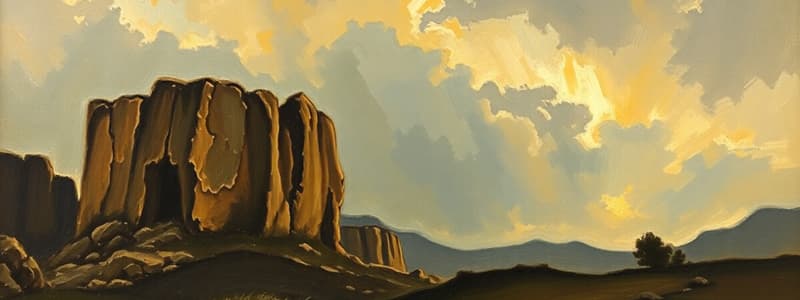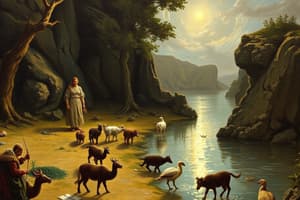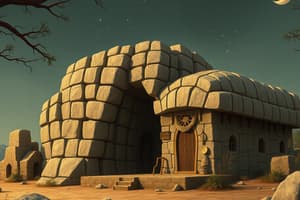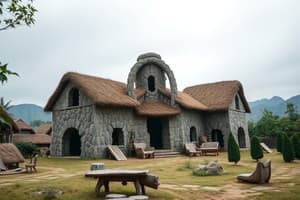Podcast
Questions and Answers
Why is the study of history important in the context of science, technology, and society?
Why is the study of history important in the context of science, technology, and society?
- It gives us insight into which ancient civilizations were superior in innovation.
- It provides context for how science and technology have shaped social, economic, and political aspects of society. (correct)
- It helps us understand the reasons behind contemporary technological advancements.
- It allows us to predict future scientific breakthroughs.
What characterizes the Paleolithic period?
What characterizes the Paleolithic period?
- The shift to a sedentary agricultural lifestyle.
- The initial development of basic stone tools by early humans. (correct)
- The emergence of writing systems.
- The development of metal tools.
Which of the following best describes the transition from the Paleolithic to the Neolithic period?
Which of the following best describes the transition from the Paleolithic to the Neolithic period?
- A rapid shift to metalworking and urbanization.
- An abrupt decline in human population due to climate change.
- A gradual period marked by the development of agriculture and settled communities. (correct)
- A distinct era characterized by advanced artistic expression.
What distinguishes the Neolithic Revolution from earlier periods?
What distinguishes the Neolithic Revolution from earlier periods?
Which of these technologies developed during the prehistoric Stone Age?
Which of these technologies developed during the prehistoric Stone Age?
What was a primary factor driving early human migration out of Africa?
What was a primary factor driving early human migration out of Africa?
How did the shift from hunting and gathering to agriculture impact human societies?
How did the shift from hunting and gathering to agriculture impact human societies?
Why did early civilizations tend to settle along river valleys?
Why did early civilizations tend to settle along river valleys?
What was the significance of the rise of ancient civilizations?
What was the significance of the rise of ancient civilizations?
Which geographical descriptor applies to Mesopotamia?
Which geographical descriptor applies to Mesopotamia?
How did the invention of the plow contribute to the development of Mesopotamian society?
How did the invention of the plow contribute to the development of Mesopotamian society?
What was the purpose of irrigation systems and dikes in Mesopotamia?
What was the purpose of irrigation systems and dikes in Mesopotamia?
How did urbanization shape Mesopotamian society?
How did urbanization shape Mesopotamian society?
What was the primary building material in the Mesopotamian city of Uruk, and why?
What was the primary building material in the Mesopotamian city of Uruk, and why?
Which statement best describes the function of ziggurats in ancient Mesopotamia?
Which statement best describes the function of ziggurats in ancient Mesopotamia?
For what purpose did Mesopotamians develop cuneiform writing around 3200 BCE?
For what purpose did Mesopotamians develop cuneiform writing around 3200 BCE?
Why were sail boats important to Mesopotamian society?
Why were sail boats important to Mesopotamian society?
What was the initial purpose of the wheel in Mesopotamia, before its use in transportation?
What was the initial purpose of the wheel in Mesopotamia, before its use in transportation?
Which of the following is a lasting contribution of Mesopotamian civilization?
Which of the following is a lasting contribution of Mesopotamian civilization?
How did the geographical location of Ancient Egypt influence its development?
How did the geographical location of Ancient Egypt influence its development?
What material did ancient Egyptians develop for writing, and from what source did it come?
What material did ancient Egyptians develop for writing, and from what source did it come?
Which statement is true of the Egyptian hieroglyphic writing system?
Which statement is true of the Egyptian hieroglyphic writing system?
What engineering accomplishments are the ancient Egyptians most known for?
What engineering accomplishments are the ancient Egyptians most known for?
Which of the following best describes the function of the clepsydra (water clock) in ancient Egypt?
Which of the following best describes the function of the clepsydra (water clock) in ancient Egypt?
What was the main purpose of mummification in ancient Egypt?
What was the main purpose of mummification in ancient Egypt?
What role did cosmetics play in ancient Egyptian society?
What role did cosmetics play in ancient Egyptian society?
What best described Ancient Greece's geography?
What best described Ancient Greece's geography?
What is unique to the Minoan civilization?
What is unique to the Minoan civilization?
What is the significance of Linear B in the context of Mycenaean civilization?
What is the significance of Linear B in the context of Mycenaean civilization?
What is a key attribute of the Geometric Period of Ancient Greece?
What is a key attribute of the Geometric Period of Ancient Greece?
What does the term 'synoekism' refer to in the context of the Archaic Period of Ancient Greece?
What does the term 'synoekism' refer to in the context of the Archaic Period of Ancient Greece?
During the Archaic Period, the Greeks adapted their alphabet from which civilization?
During the Archaic Period, the Greeks adapted their alphabet from which civilization?
What defines the rise of democracy in Ancient Greece during the Classical Period?
What defines the rise of democracy in Ancient Greece during the Classical Period?
Which is the most accurate description of the Plague of Athens?
Which is the most accurate description of the Plague of Athens?
What is the etymological meaning of philosophy, as it emerged in Ancient Greece?
What is the etymological meaning of philosophy, as it emerged in Ancient Greece?
Which of the following legacies of Ancient Greece continues to influence education today?
Which of the following legacies of Ancient Greece continues to influence education today?
What was the primary focus of Greek medicine, particularly as practiced by Hippocrates?
What was the primary focus of Greek medicine, particularly as practiced by Hippocrates?
How did Alexander the Great's death impact the political landscape of Ancient Greece?
How did Alexander the Great's death impact the political landscape of Ancient Greece?
With the death of Alexander the Great, his empire divided into what main dynasties?
With the death of Alexander the Great, his empire divided into what main dynasties?
In what way did science flourish during the Hellenistic Period?
In what way did science flourish during the Hellenistic Period?
Which of these is a lasting scientific achievement from the Hellenistic Period?
Which of these is a lasting scientific achievement from the Hellenistic Period?
Flashcards
What are Antecedents?
What are Antecedents?
Factors, things, or events that paved the way for advanced scientific and technological innovations.
What is the Paleolithic Era?
What is the Paleolithic Era?
The early phase of human history characterized by the use of stone tools.
What is the Mesolithic Era?
What is the Mesolithic Era?
The middle phase of prehistoric time, between the Paleolithic and Neolithic periods.
What is the Neolithic Era?
What is the Neolithic Era?
Signup and view all the flashcards
What is a Nomadic Lifestyle?
What is a Nomadic Lifestyle?
Signup and view all the flashcards
What is Cultural Evolution?
What is Cultural Evolution?
Signup and view all the flashcards
What is Urbanization?
What is Urbanization?
Signup and view all the flashcards
What is Mesopotamia?
What is Mesopotamia?
Signup and view all the flashcards
What is Cuneiform?
What is Cuneiform?
Signup and view all the flashcards
What is a Ziggurat?
What is a Ziggurat?
Signup and view all the flashcards
What is Ancient Egypt?
What is Ancient Egypt?
Signup and view all the flashcards
What is Papyrus?
What is Papyrus?
Signup and view all the flashcards
What are Hieroglyphs?
What are Hieroglyphs?
Signup and view all the flashcards
What is a Clepsydra?
What is a Clepsydra?
Signup and view all the flashcards
What is Mummification?
What is Mummification?
Signup and view all the flashcards
What is Minoan Civilization?
What is Minoan Civilization?
Signup and view all the flashcards
What is Mycenaean Civilization?
What is Mycenaean Civilization?
Signup and view all the flashcards
What is a Polis?
What is a Polis?
Signup and view all the flashcards
What is Democracy?
What is Democracy?
Signup and view all the flashcards
Plague of Athens
Plague of Athens
Signup and view all the flashcards
What is Philosophy?
What is Philosophy?
Signup and view all the flashcards
Who is Aristotle?
Who is Aristotle?
Signup and view all the flashcards
Who is Euclid?
Who is Euclid?
Signup and view all the flashcards
Who is Archimedes?
Who is Archimedes?
Signup and view all the flashcards
What is the Great Library of Alexandria?
What is the Great Library of Alexandria?
Signup and view all the flashcards
Who is Asclepius?
Who is Asclepius?
Signup and view all the flashcards
What were the 4 humours.
What were the 4 humours.
Signup and view all the flashcards
What are the Olympics Games?
What are the Olympics Games?
Signup and view all the flashcards
What is an Alarm Clock?
What is an Alarm Clock?
Signup and view all the flashcards
Who are Romulus and Remus?
Who are Romulus and Remus?
Signup and view all the flashcards
What is Ancient Rome
What is Ancient Rome
Signup and view all the flashcards
What is Antonine Plague?
What is Antonine Plague?
Signup and view all the flashcards
What is the "Ptolemy"?
What is the "Ptolemy"?
Signup and view all the flashcards
Study Notes
Historical Antecedents in Science and Technology
- Science and technology has continuously developed across space and time
- Scientific and technological innovations have significantly impacted social, cultural, political, and economic aspects of society, and vice versa
- Antecedents are factors, things, or events that paved the way for advanced scientific and technological innovations
Time Periods
- Prehistory
- Antiquity
- Medieval/Middle Ages
- Renaissance
- Modern Period
Prehistory: Stone Age
- Paleolithic is the old stone age which saw the development of stone tools
- Mesolithic means middle, this was the period between Paleolithic and Neolithic eras
- Neolithic is the new stone age and saw the development of metal tools which led to the Copper or Chalcolithic, Bronze and Iron ages and the development of agriculture
- The ancestors were hunters and gatherers
- They were nomadic
- They created a primitive culture and language
Prehistory: Stone Age to Bronze Age
- Controlling fire was a crucial turning point in human evolution
- Burning took place in Wonderwerk Cave approximately 1.0 Ma
- Brains evolved
- Cognitive function, communication, and cooperation developed so knowledge expanded
- Knowledge was preserved and there was progression building on past knowledge
- The main purpose of knowledge retention and advancement was survival
- Ancestors migrated out of Africa.
- Reasons for ancestor migration include decreased resources and climate changes
- Ancestors shifted from hunting and gathering to focus on agriculture
- Agriculture provided a stable food source and promoted cooperation
- Civilizations settled mostly along river valleys in Mesopotamia, Egypt, Indus Valley, and China
- Increased agricultural efficiency led to an improved quality of life and increase in population, which then resulted in the rise of civilizations
Ancient Civilizations
- The rise of ancient civilization paved the way for advances in science and technology
- Resulting in better ways of communication, transportation, weapons, self-organization, and living in general
Mesopotamia
- Mesopotamia means "land between two rivers (Tigris and Euphrates)"
- It is located in the Near East
- It included Sumer, Babylon, Ur, Uruk and other city states
- Agriculture flourished because of the fertile land (part of the Fertile Crescent)
- People transitioned from being food gatherers (hunters) to farm cultivators
- The plow was invented to dig the ground where seeds were planted
- Irrigation and dikes were constructed to bring water to the farmlands and control flooding of the rivers
- There was a shift from rural to highly populated and developed urban areas referred to as Urbanization
- The city of Uruk is considered the first true city in the world
- Buildings were made of sunbaked bricks (because no stones and lumber were available)
- Mesopotamia saw many innovations in architecture and engineering
- The Great Ziggurat of Ur was an engineering feat, the ziggurat is a pyramidal stepped temple tower
- Mesopotamia is the home of the Hanging Gardens of Babylon
- Roads were developed to facilitate faster and easier travel using sunbaked bricks on the ground
- The first writing system called cuneiform around 3200 BCE was established
- Cuneiform was written using a stylus which made wedge-like impressions in soft clay that represent word-signs, phonograms or word-concepts
- Mesopotamians primarily travelled on rivers and seas
- They constructed sailboats to transport heavy products
- They used the first wheels but not for transportation rather as potter's wheels and for farm work and food processes
- The wheel and axle (a type of simple machine) made mass production easier
- Farmers were able to mill gains faster with less effort
- Other Contributions Include:
- Mathematics
- Concept of time
- Astronomy (astrology)
- Code of Hammurabi
Ancient Egypt
- Ancient Egypt was located in North Africa, along the Nile River
- Part of the Fertile Crescent, like Mesopotamia
- Agriculture and irrigation were key to the civilizations survival
- Egyptians developed papyrus as paper from the papyrus plant (Cyperus papyrus) and ink from soot
- The ancient Egyptians developed a system of writing based on symbols called hieroglyphs
- Egyptians constructed palaces, temples, statues, and pyramids
- The water clock or clepsydra was invented
- Egyptians utilized gravity which affected the flow of water from one vessel to another
- The amount of water remaining in the devise determined how much time has elapsed since it was full
- Egyptians developed a method of embalming called mummification
- Egyptians are well known for using cosmetics, wigs, and other paraphernalia
- Egyptians developed Mathematics, metrology, astronomy, and medicine
The Age of Antiquity: Ancient Greece
- An archipelago in southeastern Europe
- The birthplace of western philosophy and made significant contributions to the field of science and technology
- The age started during the Archaic period
Minoan Civilization (2000-1400 BCE)
- Flourished in the island of Crete
- Created magnificent palace complexes
- Had a written language (Linear A) which has not been deciphered yet
- Contributions include: architecture, water management, arts and crafts
Mycenaean Civilization (1600-1100 BCE)
- Occupied mainland Greece
- Created jewelries and crafts
- Used a written language (Linear B) which has not been deciphered yet
- Contributions include: jewelries, crafts, a form of early government
- Occupied mainland Greece
- Created jewelries and crafts
- Had a written language (Linear B) which is an early form of Greek
The Dark Ages (1100-750 BCE)
- Interval between the collapse of the Mycenaean civilization and Archaic period
- Early Iron Age
- Potteries with geometric designs were common in the later part (hence also called the Geometric Period)
Archaic Period (759-480 BCE)
- The development of the polis (urban centers); also known as the city state
- Synoekism - amalgamation of villages
- Trading settlements were established across the Mediterranean
- The Phoenician alphabet adapted in Greece
Classical Period (480-323 BCE)
- A period during the Persian Wars until the death of Alexander the Great
- Political and cultural achievements
- Democracy (demokratia) saw the rule of the people
- The Plague of Athens had undefined contributing factors
- Thucydides described the Plague of Athens in his History of the Peloponnesian War
- Ancient philosophers (Socrates, Plato, Aristotle) rose to prominence in this time
- Philosophy (love for wisdom) is the process to understand fundamental truths about people, the world in which they live, and their relationships to the world and to each other with the goal to ask, answer, and argue
- Educational institutions today derived their names from centers of learning established in ancient Athens such as gymnasium, academy (from Plato), lycée (from Aristotle's lyceum)
- Advancements in art and architecture
- Investigation of diseases in medicine
- Hippocrates was the Father of Medicine
Hellenistic Period (323-30 BCE)
- Upon Alexander the Great's death, his generals struggled to find power and the right to succeed him
- Three dynasties emerged:
- The Ptolemies (Ptolemy): Egypt and South Syria (capital is Alexandria)
- The Seleucids (Seleucus, the Attalus): Asia Minor and Persia (capital is Antioch, then Pergamum)
- The Antigonids (Antigonus): Macedonia and Greece (capital is Athens)
- Greek culture spread
- Progress in different fields such as art, literature, architecture, science, and philosophy
- Science flourished due to:
- Alexander the Great encouraged research
- Stimulus provided for intellectual inquiry by the fusion of Chaldean and Egyptian science with the learning of the Greeks
- Interest in luxury and comfort and demand for practical knowledge
- Scientific achievements in mathematics, physics, astronomy, medicine
- Euclid: Father of Geometry
- Archimedes: principle of buoyancy
- Hipparchus: precession of equinoxes; trigonometry
- Importance was given to the documentation of knowledge and writings
- The Great Library of Alexandria was made
Greek Medicine
- Greek medicine intersected with the physical and spiritual worlds
- They worshiped Asclepius (god of medicine) and his daughter Hygeia (goddess of health; where we get the word hygiene)
- Focused on a healthy lifestyle
- Followed the belief of 4 Humours
- These 4 Humours were developed by Hippocrates
- They made up of 4 liquids in the body
- Blood
- Phlegm
- Yellow Bile
- Black Bile
- It was believed that for people to remain healthy the Humours needed to be balanced
- People followed this belief until the middle ages
Ancient Greek Inventions
- Alarm clock with water or small stones or sand that dropped into drums which sounded the alarm
- The upper vessel would drop water below it, which was set to be filled at a given time, then siphons the water to the next vessel at a faster rate, causing the expulsion of contained air, creating a whistling noise
- It is believed to have been used by Plato to signal the start of lecture
- Watermill powered by water rather than animals
- Was used for milling of grains
- It resulted in mass production of rice, cereals, and flour
Age of Antiquity: Ancient Rome
- Romulus and Remus were the legendary founders of Rome
- It originated as a small settlement along the Tiber river
- Culture and way of thinking was influenced by the Greeks
- Started out as a monarchy
- Evolved into a republic
- Then became an empire
- Major contributions include:
- Romance languages (Italian, Spanish, French)
- Calendar
- Alphabet
- Numerals
- Christianity
- Achievements include the construction of architecture, engineering, sanitation, and prioritized hygiene
- The also practice the branch of medicine, health. And performed specially on soldiers during campaigns
- Galen contributed to the study of anatomy and physiology
- Galen especially contributed to the study the circulatory system and diseases that resulted from Dyscrasia (imbalance of the humours)
- The goal of his medicine practice was to seek Eucrasia (balance)
- Suffered through plagues such as the Antonine and Justinian
- Ptolemy developed a geocentric model of the universe which persisted until the Middle Ages
- The Western Roman Empire fell leading to the start of the Medieval Period or Middle Ages
Studying That Suits You
Use AI to generate personalized quizzes and flashcards to suit your learning preferences.




